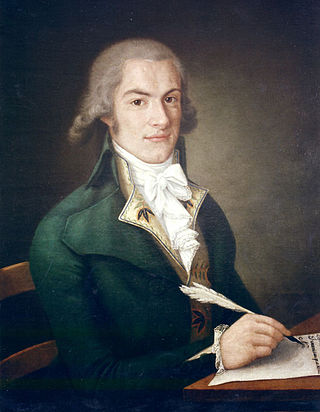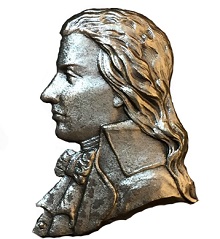Related Research Articles

Giuseppe Sinopoli was an Italian conductor and composer.

Pietro Alessandro Guglielmi was an Italian opera composer of the classical period.
Giuseppe Maria Gioacchino Cambini was an Italian composer and violinist.

Giuseppe Gazzaniga was a member of the Neapolitan school of opera composers. He composed fifty-one operas and is considered to be one of the last Italian opera buffa composers.

Francesco Feo was an Italian composer, known chiefly for his operas. He was born and died in Naples, where most of his operas were premièred.
Giuseppe Farinelli was an Italian composer active at the end of the 18th century and the beginning of the 19th century who excelled in writing opera buffas. Considered the successor and most successful imitator of Domenico Cimarosa, the greatest of his roughly 60 operas include I riti d'Efeso, La contadina bizzarra and Ginevra degli Almieri. More than 2/3 of his operas were produced between 1800-1810 at the height of his popularity. With the arrival of Gioachino Rossini his operas became less desirable with the public, and by 1817 his operas were no longer performed. His other compositions include 3 piano forte sonatas, 3 oratorios, 11 cantatas, 5 masses, 2 Te Deums, a Stabat mater, a Salve regina, a Tantum ergo, numerous motets, and several other sacred works.

Nicola Sala was an Italian composer and music theorist. He was born in Tocco Caudio and died in Naples. He was chapel-master and professor at Naples, having devoted himself to the collection of the finest models of printed music.
Marcello Bernardini was an Italian composer and librettist. Little is known of him, save that he wrote 37 operas in his career. His father was most likely the composer Rinaldo di Capua.
Ferdinando Orlandi, also referred to as Orland and Orlando. Little is known of his early life and his year of birth is also cited as 1777. He was an Italian musician and teacher of singing who composed cantatas and sacred music, but was particularly known for his operas, not all of which have survived. He was born and died in Parma.
Quirino Colombani was an Italian composer, and cellist. He was active in both 17th and 18th centuries.

San Lazzaro dei Mendicanti is an ancient church in the sestiere of Castello, Venice, northern Italy, with a facade facing a Rio of the same name. It now serves as the chapel of the Civic Hospital of Venice.
Francesco Rossi was an Italian composer, organist and Maestro di Cappella.
Tobiae matrimonium, actio sacra pro filiabus chori S. Lazari is a 1794 oratorio by Simon Mayr to a Latin libretto by Giuseppe Maria Foppa. It was the third of Mayr's works written for the Ospedale dei Mendicanti. No exact date or circumstances for the original performance are known.
David in spelunca Engaddi is a 1795 oratorio by Simon Mayr. The librettist is unknown, but is possibly Giuseppe Maria Foppa who supplied the Latin texts for Iacob a Labano fugiens (1791), Sisara (1793), and Tobiae matrimonium (1794).
Sisara is a 1793 Latin oratorio by Simon Mayr to a libretto by Giuseppe Foppa who also supplied the Latin texts for Iacob a Labano fugiens (1791) and Tobiae matrimonium (1794).
La passione di Gesù Cristo, is a 1794 Italian-language oratorio for soloists, choir and orchestra by Simon Mayr, to an adapted version of the famous libretto La passione di Gesù Cristo by Metastasio. Unlike Mayr's four Latin-language oratorios to librettos by Giuseppe Foppa for the Conservatorio dei Mendicanti, La passione was written for a church, and not limited to girls voices.
Il sagrifizio di Jefte is a 1795 oratorio by Simon Mayr to a libretto by Giuseppe Foppa performed in Forlì.

Luigi Capotorti was an Italian composer of both sacred and secular music. He was the maestro di cappella of several Neapolitan churches; the composer of ten operas, five of which premiered at the Teatro San Carlo in Naples; and a teacher of composition and singing whose students included Stefano Pavesi and Saverio Mercadante. Born in Molfetta, he studied violin and composition at the Conservatorio di Sant'Onofrio in Naples and spent his entire career in that city. In his later years, Capotorti retired to San Severo, where he died at the age of 75.
Giacomo Giuseppe Saratelli (1682-1762) was an Italian organist, composer and maestro di cappella.
References
- ↑ Archivio veneto pubblicazione periodica -1877 Page 464 "... del celebre maestro Mayr, eseguito sopra libretto con poesia italiana, mentre in antecedenza non aveva che posto in musica l'Oratorio latino Iacob a Labano Fugiens, poesia di Giuseppe Foppa, pel Conservatorio dei Mendicanti in Venezia."
- ↑ John Allitt Giovanni Simone Mayr: vita, musica, pensiero 1995 p376 "1793 Ero (cantata per Bianca Sacchetti, l'ultima direttrice dei Mendicanti, testo di Foppa) Sisara (oratorio in due parti per i Mendicanti, testo di Foppa). 1794 Stabat Mater "a quattro" n. 5 Tobia o Tobiae Matrimonium (oratorio in due parti per i Mendicanti, testo in latino e in italiano di Foppa) La Passione (oratorio in ... 1795 David in Spelunca Engaddi (oratorio in due parti per i Mendicanti, testo di Foppa?)